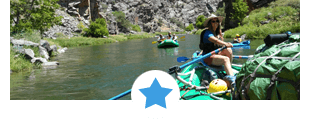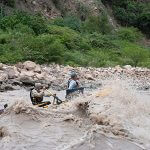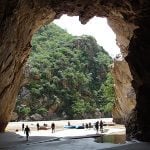Rio Marañon #9: The Jungle and Tutumberos
January 1, 2016 was our last day in the Grand Canyon of the Marañon. The original plan was to take out at Puerta Malleta, which we reached by mid-day, but we were three days early because of the high water levels. So we got a bonus added to our trip. We had time to float across the expansive Baguas valley and to spend a day in the true jungle of the Pongos section of the Rio Marañon.
The Pongos jungle section has just recently been offered for rafting trips by SierraRios. In fact, just a day’s float beyond where we would end our trip, the tribes are still unfriendly to rafters, equating them with the engineering and study groups sent down to research dam sites. The tribes downstream were so angry that they were threatening to kill rafters that floated into their territory. On the sections of the Rio Marañon where we have floated, it has taken a great amount of work by SierraRios (especially Rocky Contos and Pedro Peña) to overcome the locals’ distrust of people in rafts and to convince them that we are on their side against the dams.
The Baguas valley is broad and braided. It took a day and a half to cross it. Sometimes we would lose sight of each other for an hour at a time if we took different braided channels from one another. On the morning of January 3, the Rio Marañon was joined by two more rivers with similar volume to its own 20,000-30,000 cfs, and then the entire combined river squeezed into a narrow, jungle-lined canyon. The transition to full Amazonian jungle was dramatic and abrupt. The canyon walls were covered with thick vegetation, and we saw bright yellow and black Oropendula birds and their pendulous nests in the trees along the shore. A series of exciting rapids were normally encountered in this section of river (especially in September and October), but with the higher summer water levels of three rivers combined pushing through the canyon, most of the rapids were completely submerged. We floated serenely over rapid after rapid, viewing banana farms carved into the steep slopes of the canyon. Our one major rapid was scoutable and straight forward, providing huge standing waves including a set that gave sucker punches from both sides of the raft.
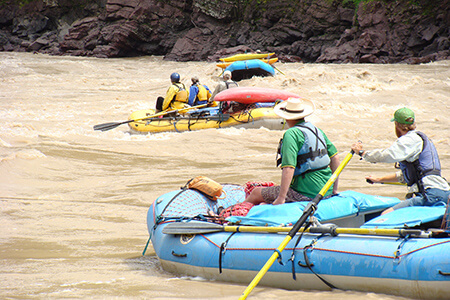
The Pongos Section
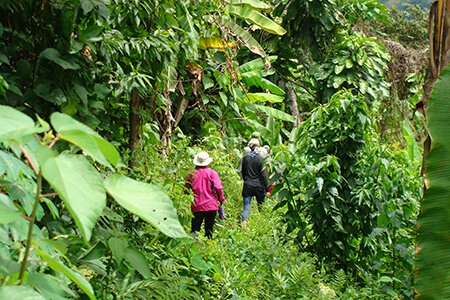
Walking to Tutumberos
We reached our destination by mid-day—the village of Tutumberos, home of the Awahun tribe. It was a rare sunny day in the jungle. We pulled our rafts into the eddy next to a small rocky beach shaded by huge trees and thick vegetation. Our host was Zecharias (clearly his western name), who was the leader of the dam resistance group for the village. He wore shorts, a t-shirt and a white plastic cowboy-hat-shaped helmet that could be strapped on for rafting. I am guessing his hat was a gift from another rafting group. Several of us wondered where we could get one like it—it was pretty cool. Zecharias was welcoming and very friendly, and led us through the jungle into his village and up the steep slope to his home, which was little more than a large palapa with a shack next to it. He introduced his wife, who shook our hands, and then they set up a long table outdoors among the chickens, where they fed us the traditional boiled chicken and rice lunch that we were becoming familiar with. We were grateful for the food and the hospitality, knowing that it took great effort to prepare, and that they had sacrificed their own chickens to the cause. SierraRios had paid the village for the meal, and each village we stopped at received a donation from part of our trip price. Zecharias brought out a large banner that read “Rio Marañon, vive sin represos” which means ‘live without dams’, and we all took a photo with the banner.
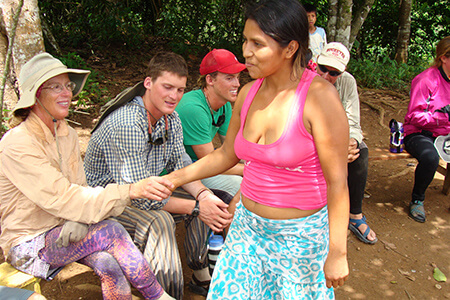
Meeting Zecharias’s wife
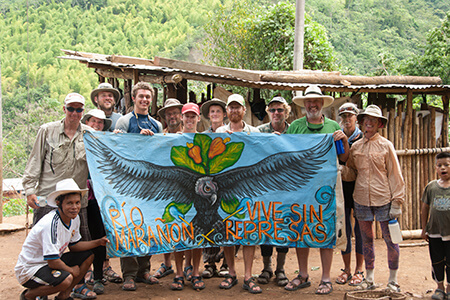
Zecharias and the group with banner
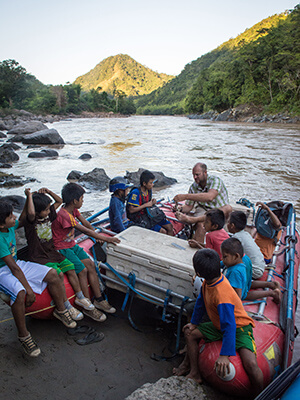
Steve hold court with the village kids
We spent the afternoon wandering through the village, swimming at the local swimming hole, and striking up a soccer game between our young men and the village men and boys. That evening, the village kids came down to our camp on the beach. Steve held court on his red cataraft with a crowd of them, showing them gear and playing with them in the universal language of smiles and giggles that needs no translation. The kids hung around and watched Glen’s cook crew make spaghetti for dinner, clearly hoping to get the leftovers. We were glad to oblige them, but there was a small drawback. The cook crew had mistakenly used a can of salsa instead of spaghetti sauce, so the dinner was very spicy. When the leftovers were offered to the kids, they served themselves big plates full and sat down hungrily to eat. Within seconds, cries of “Agua! Agua!” echoed around the beach as the kids fanned their mouths, soon dissolving into fits of laughter.
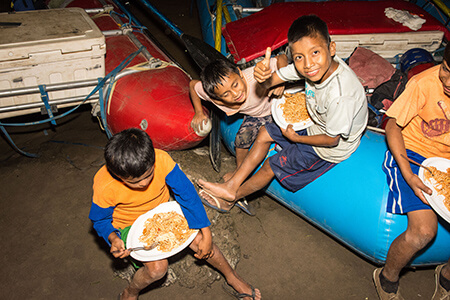
Hot spaghetti
Pedro spent much of our visit talking to representatives of the resistance against the dams. He told us later that he was trying to set up a meeting between the different tribes along this part of the river, to unit them against the dams. The tribes bickered amongst themselves and that is why some of those further downstream wouldn’t let rafting trips pass through. By the time we left Tutumberos the next morning, Pedro had forged a meeting in the regional center, Celendin, for a couple of days later.That night, the chorus of jungle insect life was deafening. It was important not to leave your flash light on when you got into your tent or a large segment of the insect population would join you inside. And these were true jungle insects in the Amazonian tradition—inches long! I wondered how so many bugs could be out at night when I hadn’t seen any of them during the day. It was kind of creepy. But once inside our tent, insects vanquished, I slept well and deeply, serenaded by their song and comforted by the abundance of life.
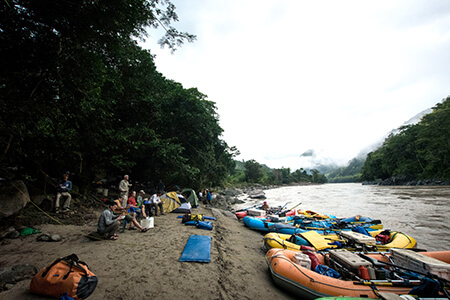
Last breakfast on the river
The next morning it was raining—a steady warm drizzle. It seemed appropriately drab for our last morning on the Rio Marañon. The group was subdued, knowing we would leave the river today. Zecharias and a few villagers came to see us off. It was only an hour float to the take-out, and then the big job of de-rigging and washing the boats and hauling the gear up the hill the truck would begin. As we pulled in to the take out point, the jungle downstream beckoned. It is funny how two weeks seems like a long time to be on a river until you experience it. Living in the moment every day, relishing every experience, soaking in the spectacular beauty all around you, time seems to fly away. And then it is over, and it feels like it only just began. But when you leave, you take it with you, that river, that canyon, that experience, and it lives inside you for the rest of your days. And you are never the same. But that’s okay, because you are better.
Read more entries in our ten-part series about the Rio Marañon.
To raft and/or help protect the Rio Marañon, contact SierraRios at www.sierrarios.org

